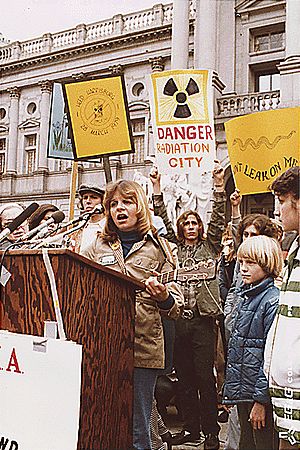Anti-nuclear protests in the United States facts for kids

Anti-nuclear protests in the United States are events where people have shown their opposition to nuclear power plants. These protests have happened since nuclear power began in the U.S. People often protest because they worry about safety, the environment, and how to store nuclear waste.
Some well-known protests include those by the Clamshell Alliance at the Seabrook Station Nuclear Power Plant. Another group, the Abalone Alliance, protested at the Diablo Canyon Power Plant. A very large wave of protests also happened after the Three Mile Island accident in 1979.
Contents
What is Nuclear Power?
Nuclear power is a way to make electricity using the energy released from splitting atoms. This process happens inside special buildings called nuclear power plants. Nuclear power can create a lot of electricity without burning fossil fuels like coal or gas. This means it does not produce greenhouse gases that cause climate change.
How Does a Nuclear Power Plant Work?
Inside a nuclear power plant, tiny particles called atoms are split apart. This splitting releases a lot of heat. This heat is used to boil water and create steam. The steam then spins large machines called turbines, which generate electricity.
Why Do People Protest Nuclear Power?
People protest nuclear power for several reasons. They often have concerns about safety, the environment, and the long-term effects of nuclear waste.
Safety Concerns
One main worry is the risk of accidents. Even though nuclear power plants are designed to be very safe, accidents can happen. If a plant has a major accident, it could release harmful radiation into the air. This radiation can be dangerous for people and the environment. It can cause serious health problems and make large areas unsafe to live in for many years.
Nuclear Waste
Another big concern is nuclear waste. After nuclear fuel is used, it remains radioactive for thousands of years. There is no easy way to get rid of this waste safely. It must be stored in special, secure places deep underground. People worry about how this waste will be kept safe for such a long time and if it could ever leak into the environment.
Environmental Impact
While nuclear power does not produce greenhouse gases, it still affects the environment. Power plants use a lot of water for cooling, which can impact local water sources. There are also concerns about the mining of uranium, which is the fuel for nuclear plants. This mining can harm the land and local ecosystems.
Famous Protests in the U.S.
Many groups and individuals have organized protests against nuclear power in the United States. These protests have taken many forms, from peaceful marches to sit-ins.
The Clamshell Alliance
The Clamshell Alliance was a group formed in 1976. They were famous for protesting the construction of the Seabrook Nuclear Power Plant in New Hampshire. Thousands of people joined their protests. They often used non-violent civil disobedience, like occupying the plant site. Their actions helped bring national attention to the anti-nuclear movement.
The Abalone Alliance
On the West Coast, the Abalone Alliance protested the Diablo Canyon Power Plant in California. This plant was built near an earthquake fault line, which worried many people. Protesters tried to stop the plant from opening. They also used peaceful protests and blockades to make their voices heard.
The Three Mile Island Accident
A very important event that fueled protests was the Three Mile Island accident. This happened in Pennsylvania in March 1979. It was the most serious nuclear accident in U.S. history.
What Happened at Three Mile Island?
At the Three Mile Island plant, a cooling system failed. This caused part of the nuclear reactor to overheat. Although no one was killed and only a small amount of radiation was released, the accident scared many people. It showed that serious problems could happen at nuclear power plants.
Impact on Protests
After the Three Mile Island accident, public opposition to nuclear power grew much stronger. Large protests happened across the country. One of the biggest was in Washington, D.C., where over 100,000 people marched. This accident made many people question the safety of nuclear power. It also led to stricter safety rules for nuclear plants in the U.S.
How Protests Made a Difference
Anti-nuclear protests have had a big impact in the United States. They helped to raise public awareness about the risks of nuclear power. Because of these protests and the concerns they raised, it became much harder to build new nuclear power plants in the U.S. Many planned projects were canceled. The protests also pushed for better safety regulations at existing plants.
See Also
- Anti-nuclear movement
- Nuclear power
- Environmental movement

